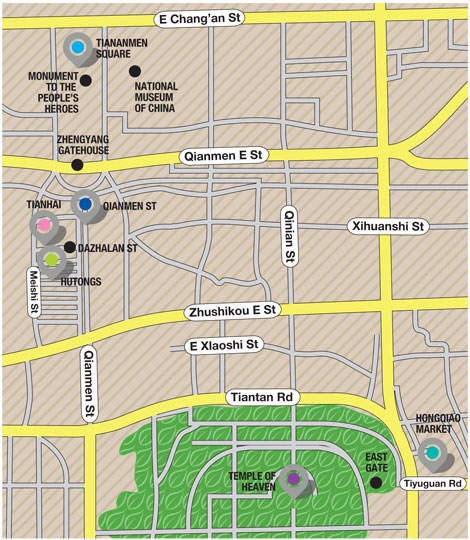Jenny Southan navigates sprawling back alleys and haggles for some not-so-authentic goods in China’s capital

TIANANMEN SQUARE
With a population of more than 22 million, the sprawling metropolis of Beijing can be hard to navigate for the time-poor, but starting in its historical and political centre is a good approach.
The largest public square in the world, Tiananmen measures 44 hectares and the scale of it is inhuman. Simply standing here is enough to give a sense of how small you are as an individual – undoubtedly the intention of former Communist chairman Mao Zedong, who oversaw its expansion in the 1950s. Tiananmen Gate at the north, with armed guards in front, has a huge portrait of him and marks the entrance to the Forbidden City. (This sprawling complex of 980 buildings is worth seeing if you have time.)
In the centre is Mao Memorial Hall, where the leader’s embalmed body lies, while to the east is the National Museum of China, and to the west the Great Hall of the People. However, it is the student pro-democracy protests of June 3 and 4 in 1989 that the site is infamous for. Take a few minutes to contemplate the hundreds – possibly thousands – of civilians who were gunned down by government troops, but note that the massacre did not happen on the square itself, but on its perimeters and surrounding streets.QIANMEN STREET
Walk to the southern end of the square to the ornate, 42-metre-tall Zhengyangmen gatehouse, originally constructed in the 15th-century Ming Dynasty as an entry point to the imperial city. Between 1949 and 1980 it was occupied by the People’s Liberation Army but it is now a tourist attraction.
Continue to the long, pedestrianised Qianmen Street, marked by a colourful gateway. An old-fashioned trolley bus trundles down here, and yellow cranes just beyond the rooftops are a reminder of the ongoing development. There has been a thoroughfare here for almost 600 years but in the run-up to the 2008 Olympics, most buildings were torn down and rebuilt in the old style – a project that also saw many surrounding hutongs (alleyways) from the 1800s destroyed. Today, Qianmen is almost clinical in appearance, with signs of globalisation in the form of Western brands such as H&M, Nike, Jack and Jones, McDonald’s and KFC sitting alongside Chinese outlets selling chopsticks and sweets.
HUTONGSDon’t spend too long on Qianmen as the cluster of hutongs that remain are far more interesting. Meandering through the maze of alleys will take you past strange stalls selling pungent meat, chefs sweating over handmade dumplings, jangling rickshaws and neon signs advertising foot massages. Some turnings will take you on to quieter, more residential streets where children play and derelict doorways lead to humble living quarters.
One of the more lively hutongs is Dazhalan Street, and at number 385 is an authentic teashop. Pop in and peruse the shelves and jars stocked with everything from ginseng and jasmine to oolong and puer. The tea is tightly packed either as large 350g-400g discs wrapped in printed paper, loose or in small balls. It’s cheap and makes a nice souvenir to take home.
TIANHAIContinuing on up the road, at 37 Dazhalan West Street is a quirky restaurant called Tianhai. Inside, a rickety staircase leads to a mezzanine level, while black and white prints decorate the walls and jars of pickled organs sit on the bar. It’s the sort of place locals come to but tourists are also welcomed.
Take a seat, order a Yanjing beer (10 yuan/95p) and choose something to eat from the illustrated menu – there are also translations, but these are more amusing than helpful. Options include “slightly fries of pond”, “slip away three kinds”, “domestic life bean curd”, “button up the pea sauce”, “black mushroom rape” and “big hot pepper fatty intestine”. Yum. The general quality of the food is good, with plenty of interesting flavours and textures.
TEMPLE OF HEAVENJump in a taxi and ask the driver to take you the 4.5km to the entrance of the Temple of Heaven in Tiantan Park (ask your hotel in advance for a card with the destinations you want to go to marked in Chinese). From here, follow the tree-lined path straight to the circular tri-tiered temple, with glazed blue tiled roofing and hand-painted exterior.
This Taoist place of worship – representing harmony between nature, humanity and the universe – is part of a complex built in the 15th century. It was deemed a UNESCO World Heritage Site in 1998 and is similar in style to that of the Forbidden City. It’s common to see local people practising tai chi or dancing among the trees in the park, and the lush grass offers a pleasant place to rest before moving on.
HONGQIAO MARKETExit via the East Gate and cross Tiantan East Road to the “Pearl Market”, which is more of a department store than a market and sells more than pearls. The ground floor is crammed full of electronic goods and watches, and is the place to browse for counterfeit Rolex, Tag Heuer or Breitling timepieces (ask and they will bring them out from under the counter).
The second floor has aisles of “designer” handbags, shirts, tailor-made suits, wallets and suitcases, though bear in mind that most, if not all, branded items will be imitations – from Ralph Lauren polo shirts to Ray Ban sunglasses. You should also haggle – the asking price could be ten times more than it should be so knock them down wildly before putting in your bid. Visit beijingpearlmarket.com









